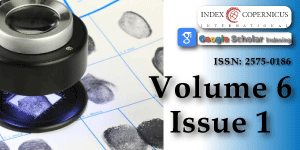Extraction of DNA from face mask recovered from a kidnapping scene
Main Article Content
Abstract
Deoxyribonucleic acid (DNA) extraction has considerably evolved since it was initially performed back in 1869. It is the first step required for many of the available downstream applications used in the field of molecular biology and forensic science. Blood samples is one of the main body fluid used to obtain DNA. This experiment used other body fluids such as saliva, sweat tears and mucus. There are many different protocols available to perform nucleic acid extraction on such samples. These methods vary from very basic manual protocols to more sophisticated methods included in automated DNA extraction protocols. This experiment used extraction kit (Zymo research). The DNA result from isolated saliva samples on the facemask range from 133.7, 213.6, 599.1 and 209.1 mg/ml. theoretically; such DNA is of much quantity and quality and can be used for forensic investigation when recovered from a crime scene. The DNA from isolated tears samples on the face mask ranges from 707.7, 202.5, 99.2, and 62.6 mg/ml. Theoretically, such DNA is of much quantity and quality and can be used for forensic investigation when recovered from a crime scene. The DNA from isolated tears samples on the face mask ranges from 615.3, 66.2, 78.5, and 68.2 mg/ml. theoretically, such DNA is of much quantity and quality and can be used for forensic investigation when recovered from a crime scene. Extracted DNA from saliva and sweat produced visible bands on agarose gel, mucous stain produce obscure band on agarose gel and the tears stain produce invisible bands. DNA from sweat satin, saliva stain, mucus stain and tears stain in face mask can be used as alternative for forensic investigation.
Article Details
Copyright (c) 2020 Nsor B, et al.

This work is licensed under a Creative Commons Attribution 4.0 International License.
Upadhyay R. Legal Status of Human Genetic Material- A Study Relating to Human DNA its Ethical Problems and Law. Kota: Department of Law University of Kota. 2018.
Martina N. Mitochondrial DNA in Sensitive Forensic Analysis. UPPSALA: Digital Comprehensive Summaries of Uppsala Dissertations from the Faculty of Medicine 220. 2007.
Akshay V. The assessment of forensic molecular markers for skin colour in South Africans. Division of Forensic Medicine and Toxicology, Faculty of Health Sciences, University of Cape Town. 2019.
Allwood J. Using DNA to predict externally visible characteristics in humans for forensic use in New Zealand. PhD dissertation. The University of Auckland. 2013.
Ali-Khan SE, Tomasz K, Rabia T, Daar AS. The use of race, ethnicity and ancestry in human genetic research. Hugo J. 2011; 5: 47–63. PubMed: https://pubmed.ncbi.nlm.nih.gov/22276086/

